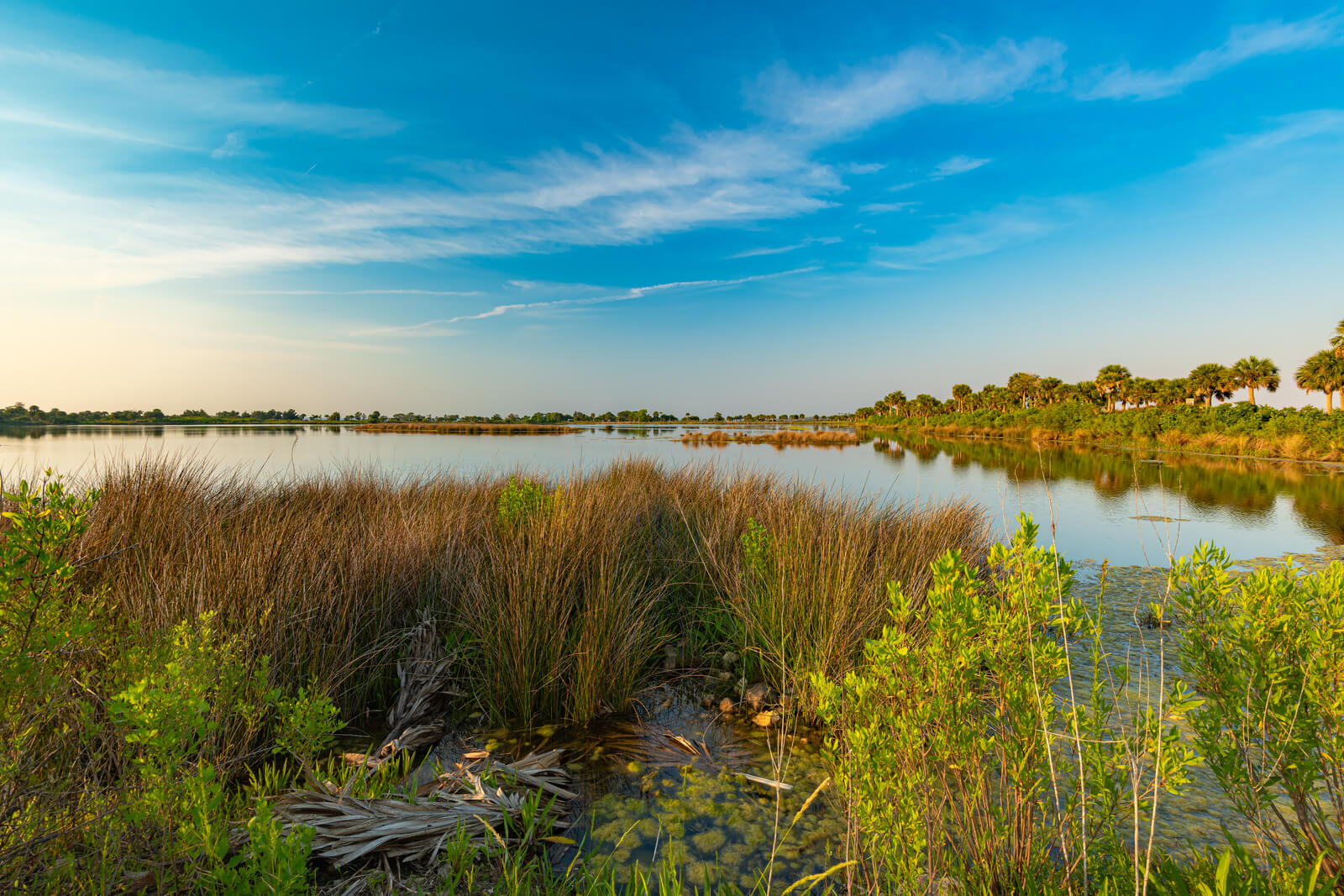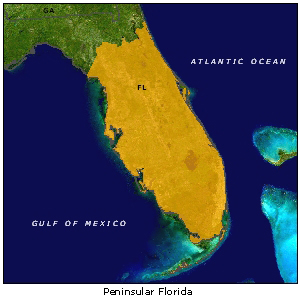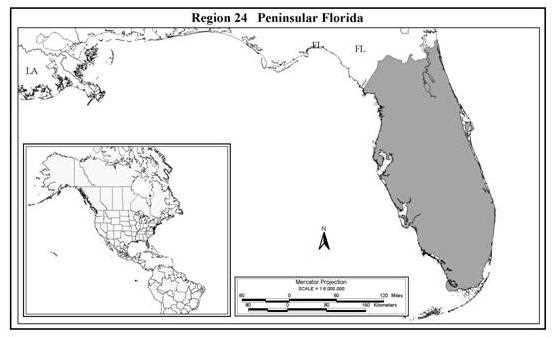Level III Ducks Unlimited conservation priority area, important wintering habitat for lesser scaup and other migratory waterfowl

The Peninsular Florida region encompasses most of Florida south of a line extending from Jacksonville to Steinhatchee on the Gulf Coast. At one time, Florida had nearly 20.4 million acres (8.22 million ha) of wetlands, of which some 9.7 million acres (3.9 million ha) were the type most valuable to waterfowl. Florida has lost millions of acres of wetlands, primarily to urbanization and agriculture. Wetlands in Florida have also been adversely affected by the introduction of several species of invasive exotic plants, such as water hyacinth. Nonetheless, Florida contains some wetland areas that serve as important migration and winter habitat in the Atlantic Flyway, nearly all of which are located within the peninsula.


The Peninsular Florida Conservation Region (Region 24*) encompasses most of Florida south of a line extending approximately from Jacksonville to Steinhatchee on the Gulf Coast. Florida had nearly 20.4 million acres of wetlands, of which some 9.7 million acres were palustrine emergent wetlands that typically were most valuable to waterfowl. Florida has lost approximately 13 million acres of wetlands, primarily to urbanization and agriculture. Wetlands in Florida have been adversely affected by introductions of several species of invasive exotic plants (e.g., water hyacinth). Nonetheless, Florida contains some wetland areas that serve as important migration and winter habitat in the Atlantic Flyway, nearly all of which are located within the peninsula.
Important waterfowl habitat in peninsular Florida occurs in association with major rivers such as the St. Johns and Kissimmee, natural lakes such as Lake Okeechobee and many smaller lakes, associated with interior prairie wetlands, and in isolated coastal areas, particularly at Merritt Island NWR. Nearly all of these wetlands have been affected to some extent by urban development or agriculture.
There are about 7,800 natural lakes in Florida, some of which produce aquatic vegetation and provide good waterfowl habitat (Johnson and Montalbano 1989). The Kissimmee River and Lakes all provide significant winter habitat for lesser scaup and ring-necked ducks. The St. Johns River Valley marshes and lakes provide winter and migration habitat for an additional 15,000 ducks on average. Unfortunately, much of the best habitat in this region has been lost to channelization, flood control, development, and drainage. Degradation of interior Florida lakes and deepwater marshes, particularly due to agricultural run-off and introduced exotic vegetation, has reduced numbers of birds over-wintering there, which likely is a direct response to reduced foraging habitat (Johnson and Montalbano 1989).
Recently, the U. S. Army Corps of Engineers has undertaken a large-scale project to restore the Kissimmee River to its former channel, which will result in restoration of several thousand ha of emergent wetlands of great value to migrating and wintering waterfowl and resident mottled ducks. The first phase of that large-scale restoration effort was completed in 2001, with the entire project scheduled for completion in 2010. Peninsular Florida south of Alachua County has a resident mottled duck population of approximately 25,000-50,000 birds. Mottled ducks use interior wetlands and prairies extensively in Florida, and make only limited use of coastal habitats (Johnson et al. 1984, 1991). The Florida Fish and Wildlife Conservation Commission (FFWCC) completed a mottled duck conservation plan in 2003. The goal of that plan is to "maintain the Florida mottled duck as a functional member of the South Florida ecosystem, at a population that can sustain hunting and viewing opportunities over the long term." Ducks Unlimited conservation programs in peninsular Florida should, where and when possible, contribute directly toward the overall goals and objectives of the FFWCC Mottled Duck Conservation Plan.
The other major wetland ecosystem in the peninsula is Lake Okeechobee and the Everglades. With exception of Lake Okeechobee and an area referred to as the Everglades Agricultural Area located immediately south of the lake, the Everglades and associated habitats do not provide very high quality waterfowl habitat and winter relatively few birds. This system suffers from extensive alterations to hydrology for urban water supply demand, flood control, and eutrophication related to agricultural practices (Johnson and Montalbano 1989). Multiple canals and large water control structures divert much of the water for irrigation or municipal water supply to large metropolitan areas like Miami. Heavy fertilizer use on these relatively nutrient poor soils also has lead to heavy nutrient loading in the system, particularly for phosphorous. As a result, the everglades tend to be drier and water quality is poorer than in the relatively recent past, while Lake Okeechobee tends to be held at higher levels not conducive to growth of waterfowl food plants (Johnson 1987, Johnson and Montalbano 1989). A large, multi-agency effort, lead by the U. S. Army Corps of Engineers and the South Florida Water Management District, is underway to restore the hydrology of this system and reduce nutrient loading. Various projects within this effort will be authorized through 2014, with subsequent completion subject to appropriation of funding. DU has not participated and has no plans to increase its direct involvement in the large-scale restoration effort in the Everglades due to the relatively low value of waterfowl habitat provided by the system.
*Region 24 - NABCI conservation Region 31
As noted previously, Lake Okeechobee and the Everglades Agricultural Area (rice, tomatoes and other truck-farm type crops, and sugar cane) winter an average of 170,000 ducks, of which scaup (<97,000) and ring-necked ducks (<35,000) are the most abundant species (Johnson 1987, Johnson and Montalbano 1989). Blue-winged teal also are common in winter on Lake Okeechobee and throughout the Everglades region. Mottled ducks and fulvous whistling ducks are present at relatively low densities (Johnson and Montalbano 1989, Moorman and Gray 1994).
Along Florida's Atlantic Coast, Merritt Island NWR contains brackish impoundments that produce abundant stands of wigeon grass. These impoundments originally created to control mosquitoes, typically over-winter several thousand dabbling ducks, including wigeon, pintails, and mottled ducks (Gordon et al. 1989). Also, the Indian and Banana Rivers provide important winter habitat for 200,000 to 300,000 lesser scaup. On the Gulf Coast, Tampa Bay and Charlotte Harbor winter 45,000 and 20,000 scaup, respectively. Other coastal areas offer considerably less waterfowl habitat relative to interior wetlands discussed above.
One migrant population and one resident population of greater sandhill cranes occur in this area. The Eastern Population, which breeds in Ontario, Minnesota, Wisconsin and Michigan, over-winters primarily in southeastern Georgia through central Florida. A resident population of cranes occurs in peninsular Florida (Tacha et al. 1994). Much of the population of limpkins in North America occurs in association with cypress and bottomland hardwood swamps in Florida, with a small number of birds in extreme southwestern Georgia (Gough et al. 1998).
Substantial numbers of shorebirds use this region, particularly the Atlantic coast of Florida and the mudflats and beaches of the eastern Gulf Coast of Mexico. Wetlands in Florida are among the most important in North America for vast numbers of wading birds. In particular, the Everglades region has great significance to colonial wading birds, including nearly all species of herons, egrets and bitterns in North America, white ibis, limpkins, and wood storks. Many of these species annual events are linked to the annual flooding and gradual drying of the Everglades system. Alterations to hydrology in the Everglades have been responsible for a dramatic decline in the number of wading birds in this conservation region. This region also supports populations of endangered snail kites and Florida panthers. Also, efforts are underway to re-establish a resident population of whooping cranes.
DU's conservation accomplishments in Florida have grown in recent years. In 2003, DU received a NAWCA grant to restore the Hickory Mound Impoundment in the Big Bend Region of Florida. Also, DU has partnered with the USDA NRCS to complete some large, site-specific Wetland Reserve Program projects in Florida. The remaining accomplishments in Florida are all related to the MARSH programIn Peninsular Florida, DU has worked with the FFWCC, the USFWS and other partners to conserve 9,284 ha of wetlands. Conservation staff are currently evaluating the need and potential expansion of conservation programs in Florida, particularly in the arena of conservation easements and private lands programs.
Ducks Unlimited uses cookies to enhance your browsing experience, optimize site functionality, analyze traffic, and deliver personalized advertising through third parties. By continuing to use this site, you agree to our use of cookies. View Privacy Policy